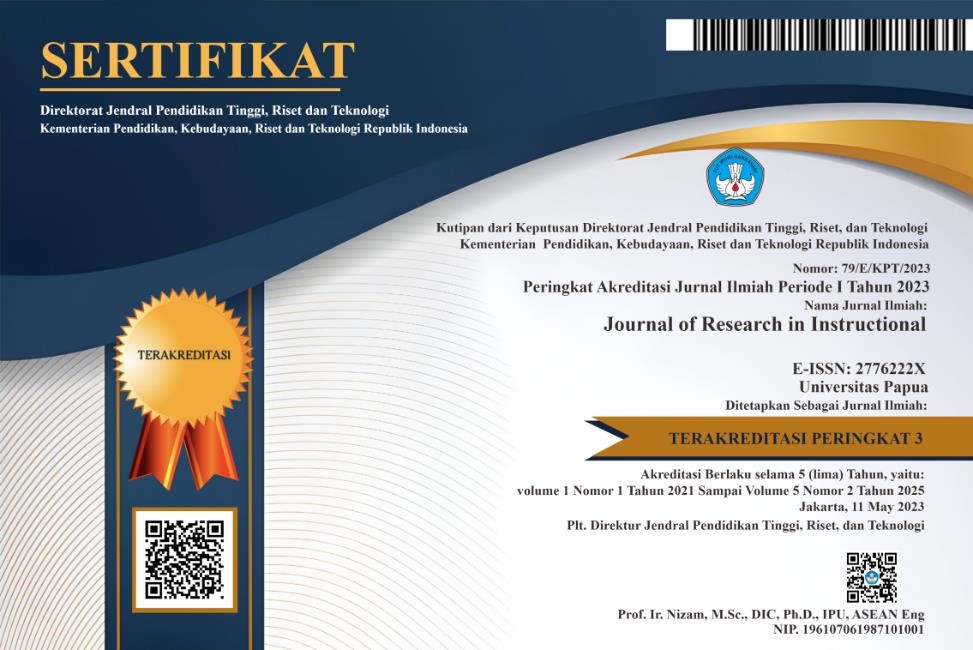Using structural equation modelling to investigate the mediating effects of TPACK on intention to use technology
DOI:
https://doi.org/10.30862/jri.v4i2.483Keywords:
Mediation, structural equation modelling, TPACK, use of technology, UTAUTAbstract
This article aims to understand, through structural equation modelling (SEM), how the knowledge of technological pedagogical and content knowledge (TPACK) mediates the intention to accept and use technology by teachers’ college lecturers. The ultimate aim is to come up with a sem-generated model which teacher training colleges can use to train lecturers in technology use. Structural equation modeling is a sophisticated multivariate statistical process that enables researchers to analyze the direct and indirect effects of variables on one another, construct theoretical concepts, test the reliability of their measurements, hypothesize and test a theory about their relationships, and account for measurement errors. A questionnaire founded on the unified theory of acceptance and use of technology (UTAUT) was employed to gather data from instructors at ten teacher-training colleges. Simple random sampling was used to select 300 valid questionnaires used in the analysis. Statistic package R was used to run SEM and the results confirmed the mediating role of TPACK in the behavior intention to accept and use technology by lecturers.
References
Baron, R. M., & Kenny, D. A. (1986). The moderator-mediator variable distinction in social psychological research: Conceptual, strategic, and statistical considerations. Journal of Personality and Social Psychology, 51(6), 1173–1182. https://doi.org/10.1037/0022-3514.51.6.1173
Bindu, C. (2016) Impact of ICT on teaching and learning: A literature review. International Journal of Management and Commerce Innovations (2016), 4(1), 24-31.
Cheung, George & Chan, Kevin & Brown, Ian & Wan, Kelvin. (2016). Teachers' Knowledge and Technology Acceptance: A Study on the Adoption of Clickers. Proceedings of the 11th International Conference on e-Learning, (pp. 46-51). Academic Conferences Limited. https://research.polyu.edu.hk/en/publications/teachers-knowledge-and-technology-acceptance-a-study-on-the-adopt
Davis, F. D. (1989). Perceived usefulness, perceived ease of use, and user acceptance of information technology. Information Systems Journal, 13(9), 319–340. https://doi.org/10.1021/jf001443p
Hair, J. F., Black, W. C., Babin, B. J., & Anderson, R. E. (2014). Multivariate data analysis (7th ed.). Pearson Education.
Harris, J. B., & Hofer, M. (2011). Technological pedagogical content knowledge in action: A descriptive study of secondary teachers’ curriculum-based, technology-related instructional planning. Journal of Research on Technology in Education, 43, 211–229. https://doi.org/10.1080/15391523.2011.107825701707
Hayes, A. F. (2013). Introduction to mediation, moderation, and conditional process analysis: A regression-based approach. Guilford Press.
Hayes, A. F., & Rockwood, N. J. (2017). Regression-based statistical mediation and moderation analysis in clinical research: Observations, recommendations, and implementation. Behaviour Research and Therapy. 98, 39–57. https://doi.org/10.1016/j.brat.2016.11.001
Horn, J. L. (1965). A rationale and test for the number of factors in factor analysis. Psychometrika 30, 179–185 (1965). https://doi.org/10.1007/BF02289447
Joo, Y. J., Park, S., & Lim, E. (2018). Factors influencing preservice teachers ’ intention to use technology: TPACK, teacher self-efficacy, and technology acceptance model. Educational Technology & Society, 21(3), 48–59. https://www.jstor.org/stable/26458506
Khan, S. A., Zainuddin, M., Mahi, M., & Arif, I. (2020, December 15). Behavioral intention to use online learning during COVID-19 : An analysis of the technology acceptance model. International Conference on Innovative Methods of Teaching and Technological Advancements in Higher Education [Conference presentation], European University, Georgia.
Kitchenham, B, & Pfleeger, S. L. (2001). Principles of survey research. ACM SIGSOFT Software Engineering Notes, 26(6), 16. https://doi.org/10.1145/505532.505535
Koch, A., Heo, M., & Kush, J. (2012). Technology integration into pre-service teacher training. International Journal of Information & Communication Technology Education, 8(1), 1-14. https://doi.org/10.4018/jicte.2012010101
Kopcha, T. J. (2010). A systems-based approach to technology integration using mentoring and communities of practice. Educational Technology and Research Development, 58, 1042–1629. https://doi.org/10.1007/s11423-008-9095-4
Lei, J. (2014). Digital natives as preservice teachers: What technology preparation is. Journal of Computing in Teacher Education, 25(3), 37–41. https://doi.org/10.1080/10402454.2009.10784615
Muller, D., Judd, C. M., & Yzerbyt, V. Y. (2005). When moderation is mediated and mediation is moderated. Journal of Personality and Social Psychology, 89(6), 852–863. https://doi.org/10.1037/0022-3514.89.6.852
Sair, S. A., & Danish, R. Q. (2018). Effect of performance expectancy and effort expectancy on the mobile commerce adoption intention through personal innovativeness among Pakistani consumers. Pakistan Journal of Commerce and Social Science, 12(2), 501-520
Schmidt, D. A., Baran, E., Thompson, A. D., Mishra, P., Koehler, M. J., & Shin, T. S. (2009). Technological pedagogical content knowledge (TPACK). Journal of Research on Technology in Education, 42(2), 123–149. doi:10.1080/15391523.2009.10782544
Schumacker, R. E., & Lomax, R. G. (2004). A beginner’s guide to structural equation modeling (2nd ed.; D. Riegert, Ed.). Mahwah, NJ: Lawrence Erlbaum Associates
Shulman, L. S. (1986). Those who understand: Knowledge growth in teaching. American Education Research Association, 15(2), 4–14. https://doi.org/10.1017/CBO9781107415324.004
Tabachnick, B. G., & Fidell, L. S. (2014). Using multivariate statistics (6th ed.). Pearson Education.
Teo, T. 2011. Factors influencing teachers’ intention to use technology: Model development and test. Computer & Education. 57(4), 2432-2440. https://doi.org//10.1016/j.compedu.2011.06.008
Thomas, T., Herrring, M., Redmond, P., & Smaldino, S. (2013). Leading change and innovation in teacher preparation: A blueprint for developing TPACK ready teacher candidates. Techtrends, 57(5), 55-63. http://dx.doi.org/10.1007/s11528-013-0692-7
Venkatesh, V, Morris, M. G., Davis, G. B., & Davis, F. D. (2003). User acceptance of information technology: Toward a unified view. MIS Quarterly, 27(3), 425–478. https://doi.org/10.2307/30036540
Yılmaz, A. (2021). The effect of technology integration in education on prospective teachers' critical and creative thinking, multidimensional 21st century skills and academic achievements. Participatory Educational Research, 8(2), 163-199. https://doi.org/10.17275/per.21.35.8.2
Downloads
Published
Issue
Section
License
Copyright (c) 2024 Havatidi Madzamba, Alois Matorevhu

This work is licensed under a Creative Commons Attribution-ShareAlike 4.0 International License.






